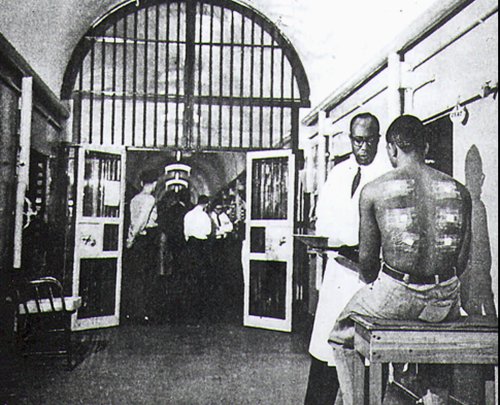U.S. experimented on disabled citizens and prison inmates: AP
By 신용배Published : Feb. 28, 2011 - 16:25
ATLANTA (AP) - Shocking as it may seem, U.S. government doctors once thought it was fine to experiment on disabled people and prison inmates. Such experiments included giving hepatitis to mental patients in Connecticut, squirting a pandemic flu virus up the noses of prisoners in Maryland, and injecting cancer cells into chronically ill people at a New York hospital.
Much of this horrific history is 40 to 80 years old, but it is the backdrop for a meeting in Washington this week by a presidential bioethics commission. The meeting was triggered by the government's apology last fall for federal doctors infecting prisoners and mental patients in Guatemala with syphilis 65 years ago.
U.S. officials also acknowledged there had been dozens of similar experiments in the United States - studies that often involved making healthy people sick.
An exhaustive review by The Associated Press of medical journal reports and decades-old press clippings found more than 40 such studies. At best, these were a search for lifesaving treatments; at worst, some amounted to curiosity-satisfying experiments that hurt people but provided no useful results.
Inevitably, they will be compared to the well-known Tuskegee syphilis study. In that episode, U.S. health officials tracked 600 black men in Alabama who already had syphilis but didn't give them adequate treatment even after penicillin became available.
These studies were worse in at least one respect - they violated the concept of "first do no harm," a fundamental medical principle that stretches back centuries.
"When you give somebody a disease - even by the standards of their time - you really cross the key ethical norm of the profession," said Arthur Caplan, director of the University of Pennsylvania's Center for Bioethics.
Some of these studies, mostly from the 1940s to the '60s, apparently were never covered by news media. Others were reported at the time, but the focus was on the promise of enduring new cures, while glossing over how test subjects were treated.

Attitudes about medical research were different then. Infectious diseases killed many more people years ago, and doctors worked urgently to invent and test cures. Many prominent researchers felt it was legitimate to experiment on people who did not have full rights in society - people like prisoners, mental patients, poor blacks. It was an attitude in some ways similar to that of Nazi doctors experimenting on Jews.
"There was definitely a sense - that we don't have today - that sacrifice for the nation was important," said Laura Stark, a Wesleyan University assistant professor of science in society, who is writing a book about past federal medical experiments.
"미국에서 비윤리적 생체실험 수십건"
(애틀랜타 AP=연합뉴스) 미국에서 1900년대 중반까지 정부 지원하에 재소자, 정 신질환자 등을 상대로 건강한 사람을 독감, 간염, 임질 등에 감염시키는 비윤리적 실험이 자행됐던 것으로 나타났다.
28일 AP통신이 과거의 의료실험 관련 기사와 학술지 등 방대한 자료를 자체 조 사한 결과, 연방정부 등 미 정부기관 지원 아래 교도소 재소자나 정신질환자 등을 상대로 인체실험을 벌인 사례가 40건 이상 확인됐다.
1942년 미시간주 입실랜티에서 이뤄진 한 연구에서는 정신질환자 수용소 환자들 에게 실험 단계의 독감 백신을 접종한 후 독감 바이러스에 노출시킨 결과 당시 보도 에 따르면 대상자들이 '노망, 심신쇠약' 등의 증상을 보였던 것으로 드러났다.
또 1950년대 애틀랜타의 연방 교도소에서는 정부 연구자들이 자원한 재소자 20 여명을 대상으로 임질균을 요도에 직접 주입하거나 또는 감염 여성과 성 접촉을 갖 게 해 임질 감염 정도를 비교하는 실험을 벌였다.
1957년에는 메릴랜드 제섭의 교도소 재소자 23명을 대상으로 당시 유행하던 아 시아 독감 바이러스를 코에 분무하는 실험이 행해졌는가하면, 1940년대 뉴욕주의 재 활형무소 재소자들에게 치명적인 위(胃)내 세균 전파 속도를 알아보려고 거르지 않 은 변기 내 부유물을 마시게 한 사례도 발견됐다.
심지어 유명 연구자들이 가담한 실험도 적지 않았는데, 간염 유형을 처음 구분 한 것으로 유명한 폴 헤이븐스 주니어 박사의 경우 1940년대 코네티컷 미들타운과 노위치의 정신질환자들에게 간염균을 노출시키는 연구를 벌여 건강한 남성 8명이 간 염을 앓게 됐던 것으로 나타났다.
이들 연구는 '우선 (환자에게) 해를 끼치지 말라'는 의료의 근본 개념을 위반한 데다, 대상자에게 해를 끼치고서도 유용한 결과가 나오지 않고 단순 호기심만 충족 시킨 사례도 있었다.
이들 연구 중 일부는 당시 언론에 공개되지 않았으며, 다른 연구들은 보도는 됐 으나 언론매체들이 실험 결과에만 주목했을 뿐 실험대상자들의 처우에 대해서는 대 충 넘어갔다.
특히 이들 실험의 대상자들은 통상 자원한 것으로 보도됐으나, 실제로 이들이 실험 내용과 이유 등에 대해서 제대로 설명을 들었는지, 또는 강요됐는지 여부에 대 해 역사학자들과 윤리학자들은 의문을 제기하고 있다.
미국에서는 1940~50년대 의약산업이 급성장하면서 교도소내 인체실험이 급증, 1 960년대에는 미국 내 주 중 최소 절반이 재소자를 실험대상으로 쓰는 것을 허용한 상태였다.
미 정부는 작년 10월 미국이 1940년대 과테말라에서 고의로 매독균 등을 교도소 나 정신병원 수감자에게 감염시키는 실험을 한 사실을 인정하고 과테말라 정부에게 사과한 바 있다.
이와 관련, 미국 관리들은 많은 경우 건강한 사람을 감염시킨 유사한 실험들이 미국 내에서도 수십 건 행해졌다고 인정했었다.










![[Today’s K-pop] BTS pop-up event to come to Seoul](http://res.heraldm.com/phpwas/restmb_idxmake.php?idx=644&simg=/content/image/2024/04/17/20240417050734_0.jpg&u=)
![[Graphic News] More Koreans say they plan long-distance trips this year](http://res.heraldm.com/phpwas/restmb_idxmake.php?idx=644&simg=/content/image/2024/04/17/20240417050828_0.gif&u=)




![[KH Explains] Hyundai's full hybrid edge to pay off amid slow transition to pure EVs](http://res.heraldm.com/phpwas/restmb_idxmake.php?idx=652&simg=/content/image/2024/04/18/20240418050645_0.jpg&u=20240419100350)

